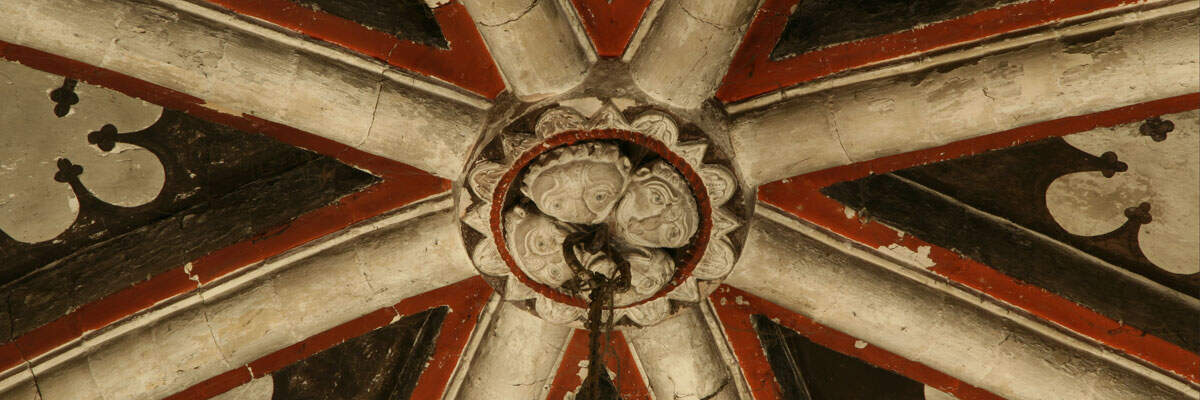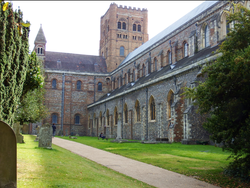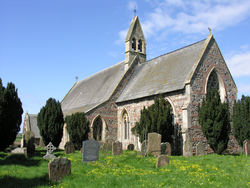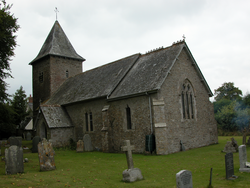
The Corpus of ROMANESQUE SCULPTURE in Britain & Ireland

St Alban (medieval)
Cathedral, formerly Benedictine monastery
The church begun by Abbot Paul of Caen (1077-93) in 1077 had an aisled eastern arm of 4 bays; the central vessel with an apse and the aisles perhaps apsed too (see Fernie 2000, 112), although nothing has been found to clarify the arrangement.The cruciform church had 3-bay transepts; the inner bays corresponding to the nave and chancel aisles, with a pair of stepped chapels on the E side of each. The exterior view from the east would thus have shown an echelon of 7 apses. The nave was originally of 10 bays. The nave elevation is of 3 storeys with a tribune gallery and clerestorey above the arcade. As a whole the articulation is very plain with practically no shafts, probably a result of the building materials used in the construction. The church is largely of flint with re-used Roman brick taken from the Roman site of Verulamium used for strengthening and as dressing where right angles were needed.
The new church was consecrated in 1115, in the abbacy of Abbot Paul's successor Richard d'Aubeney (1097-19), then from the end of the 12thc, Abbot John de Cella lengthened the nave by 3 bays, rebuilding the westernmost bay in the process. He also commissioned a new W front from Hugh of Goldclif, described by Matthew Paris as 'an untrustworthy and deceitful man, but a consummate craftsman'. True to form, Goldclif used up all the money and kept demanding more until the abbot could stand it now longer. Goldclif was dismissed and the incomplete facade left to crumble for want of funding to complete it. After more several delays the W end was eventually completed c.1230 under Abbot William of Trumpington (1214-35). The eastern arm was rebuilt and extended eastwards in the 13th; the work beginning with a rebuilding of the choir aisles from 1235, and including a new presbytery, a feretory for the shrine of St Alban, a retrochoir and a Lady Chapel at the E end. The last of these was completed early in the 14thc. In 1323 bays 5 to 9 of the S nave arcade were rebuilt (to match the Early English work further west) following a collapse.
After the Dissolution of the abbey in 1539 the monastic buildings were sold to Sir Richard Lee for building materials, and the church passed to the town. The east end was converted into a Grammar School, and the remainder became a parish church, apparently ill-maintained. Part of the S nave wall fell through the aisle roof in 1832, and repairs were carried out by L. N. Cottingham. A campaign of restoration was carried out by Sir Gilbert Scott from 1856 to 1877, and he restrored the S nave clerestorey, reroofed the S aisle restored the Lady Chapel and stabilised the crossing tower. He also reunited the E end with the rest of the church. Restoration was continued by Lord Grimthorpe after Scott's death, and his approach was much more intrusive. In the 1880s and '90s he completely rebuilt the west front and the transept facades as well as restoring the Lady Chapel, eastern arm and nave, all at his own expense, and he was heavily criticized for his approach. Meanwhile in 1877 the diocese of St Albans had been consituted, with the abbey as its cathedral. The see initially covered Hertfordshire, Bedfordshire and Essex, although the last of these gained its own see at Chelmsford in 1914.
Parish church
The Victorian church is of boulders and rubble striped with brick, and has ashlar dressings. For description and illustration of the church before rebuilding, see Poulson 1840-1, I, 469; also illustrated in VCHER VII, fig. 35. From the various features mentioned, there had been frequent alterations over the centuries, and more are recorded in the 19thc. This history culminated in a rebuilding in 1855 by Mallinson and Healey ‘incorporating old materials’ according to Pevsner and Neave 1995, 763 (in 1854, according to VCHER VII, 413). There are no medieval remains except for six chevron voussoirs reset in exterior walls.
Parish church
The church has chancel, aisleless nave and W tower. It seems to be mainly 13thc. - 14thc. but much is restored. The structure is mainly composed of redstone rubble with some reused ashlar blocks in the N wall of the chancel which may have been from an earlier building. Pevsner suggests that this is 12thc. Reset Romanesque sculpture is built into the S doorway. The church was restored in 1871 by Samuel Hooper (Pevsner, 160).


